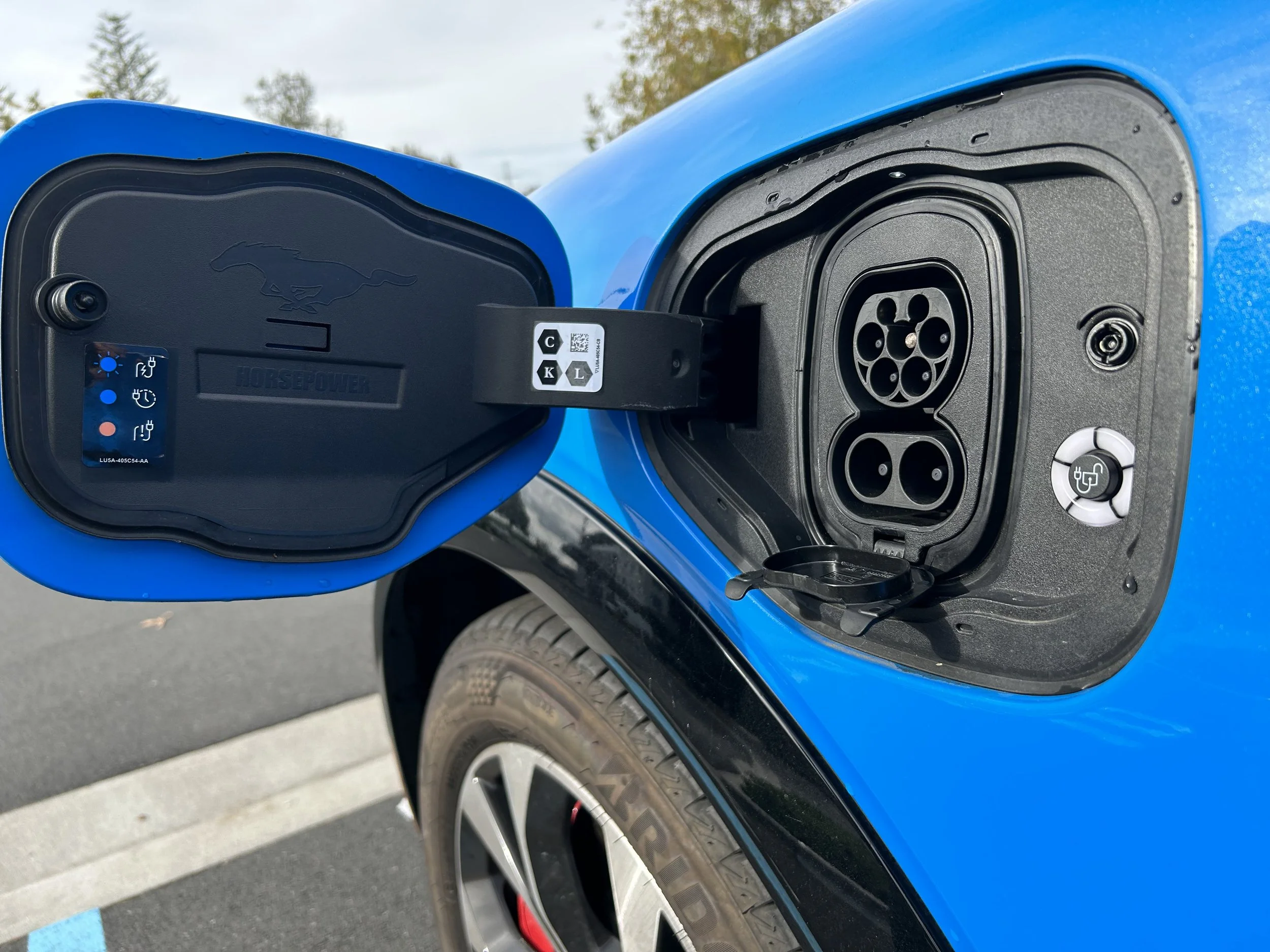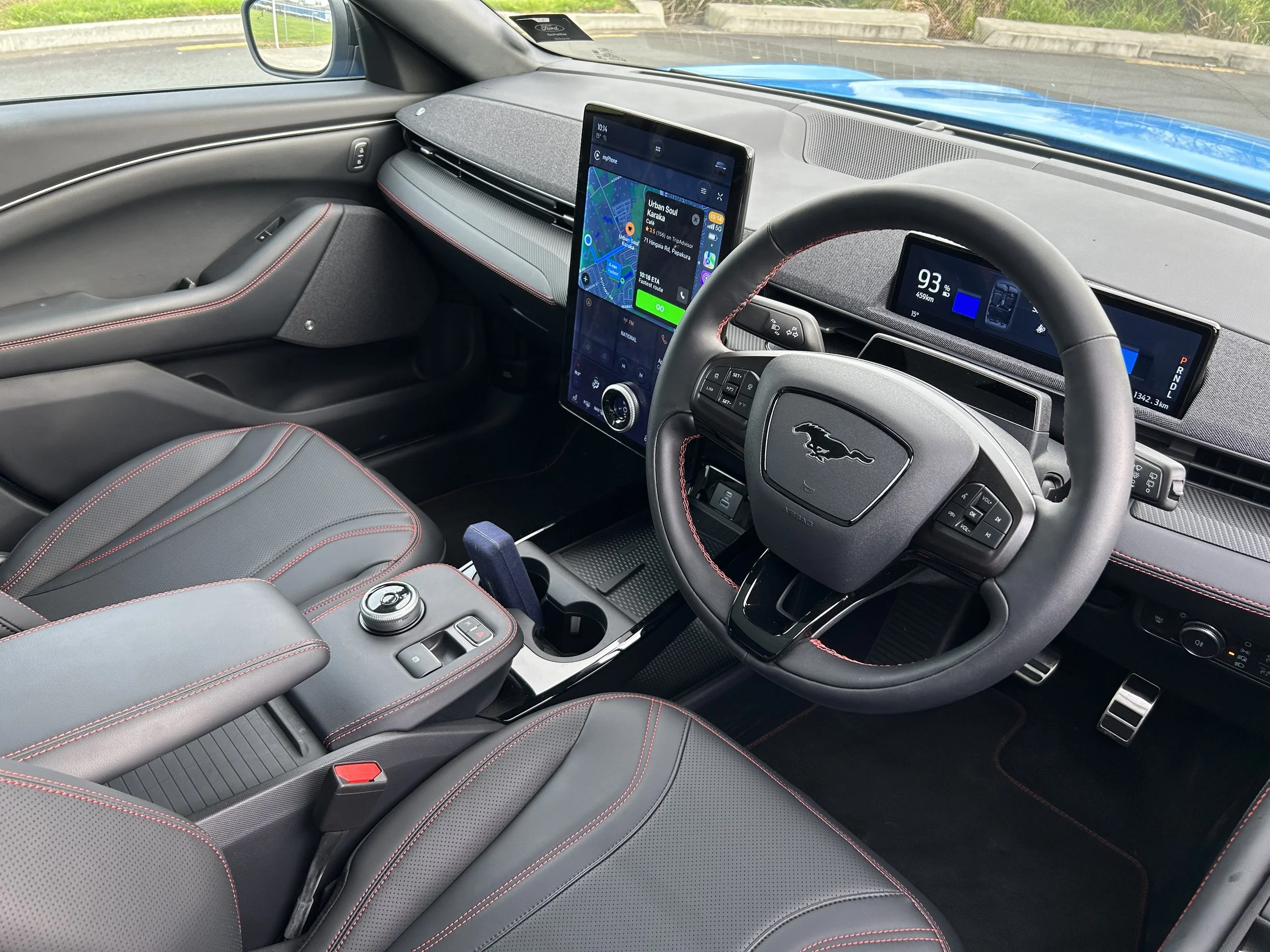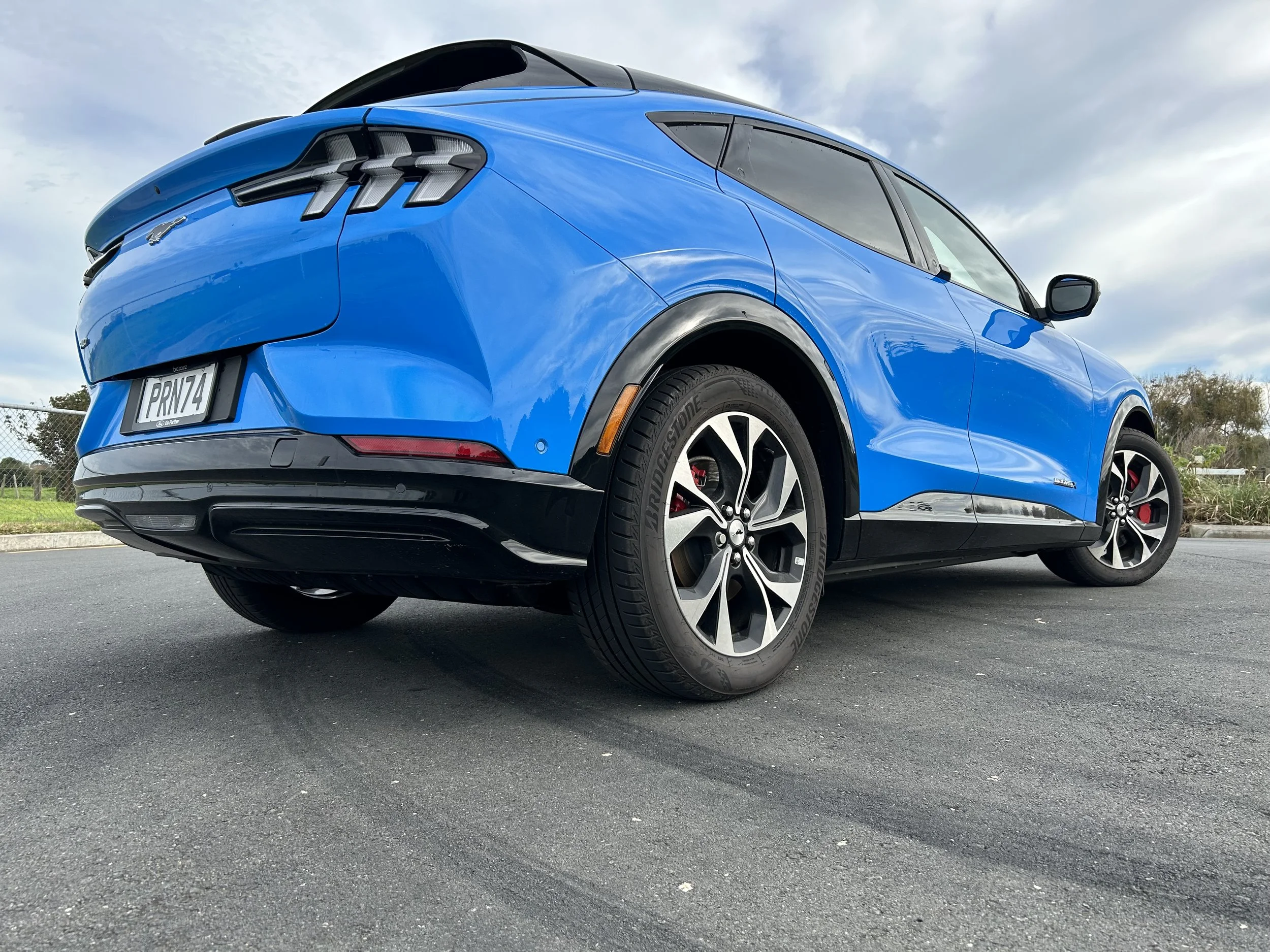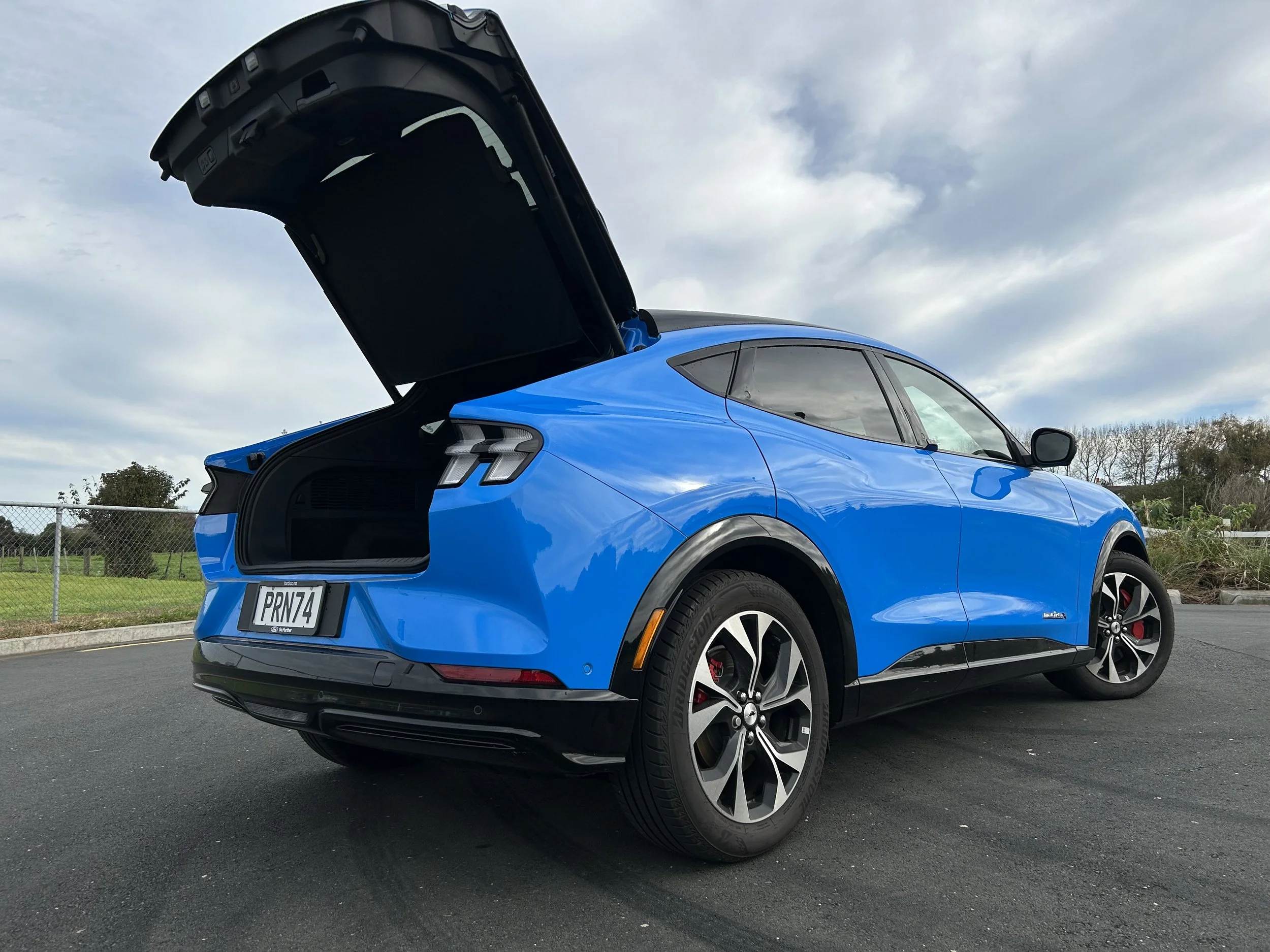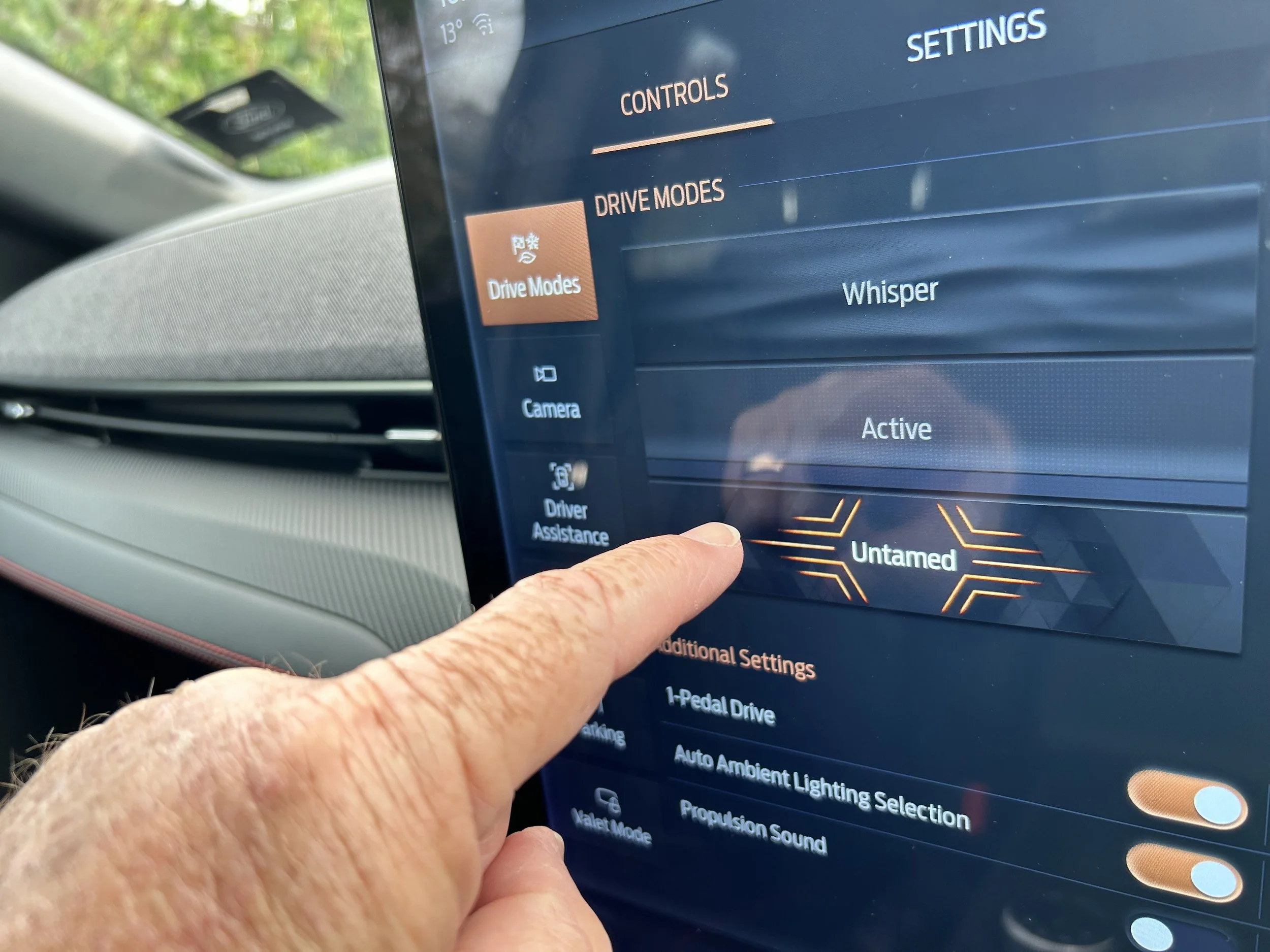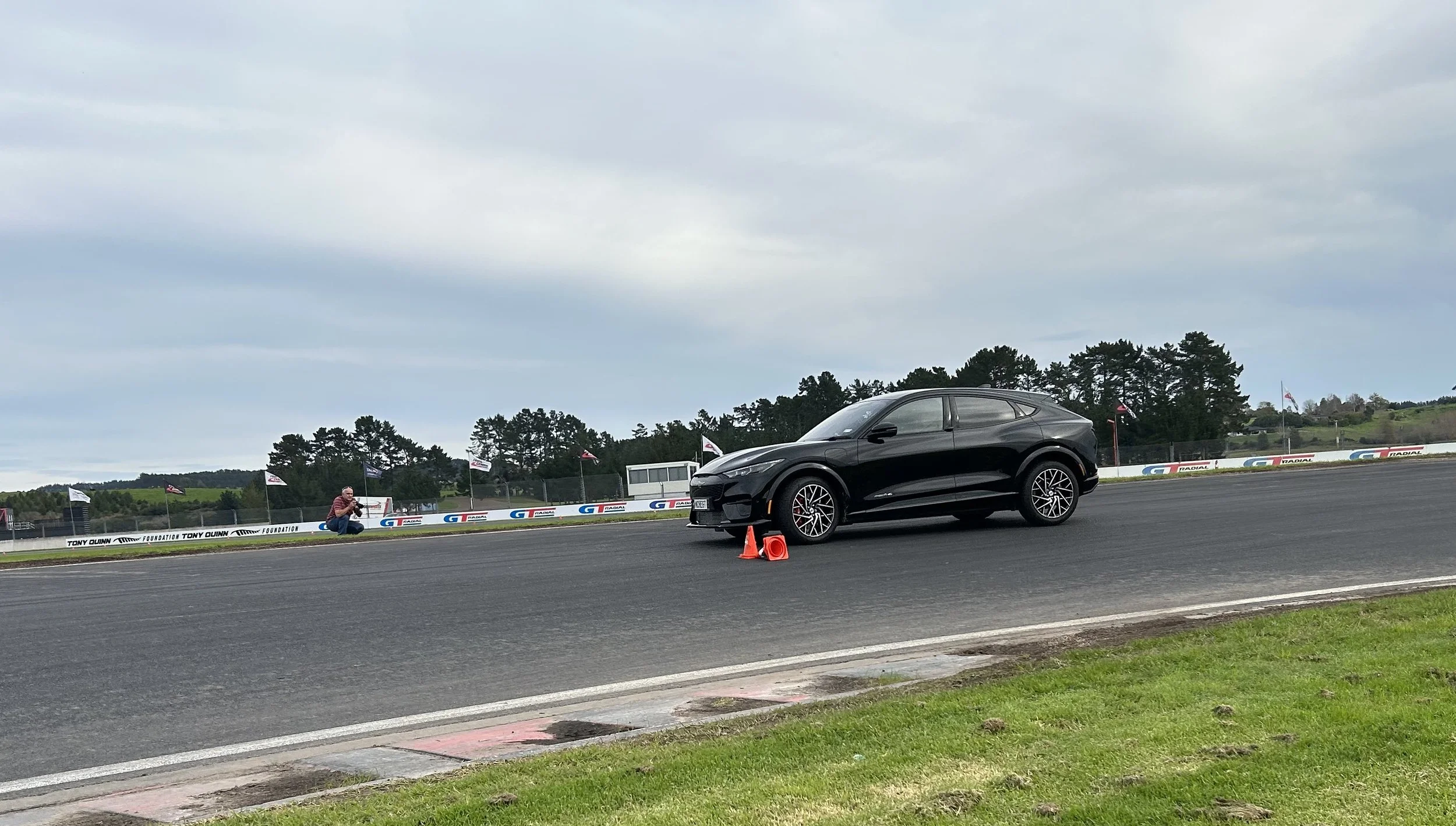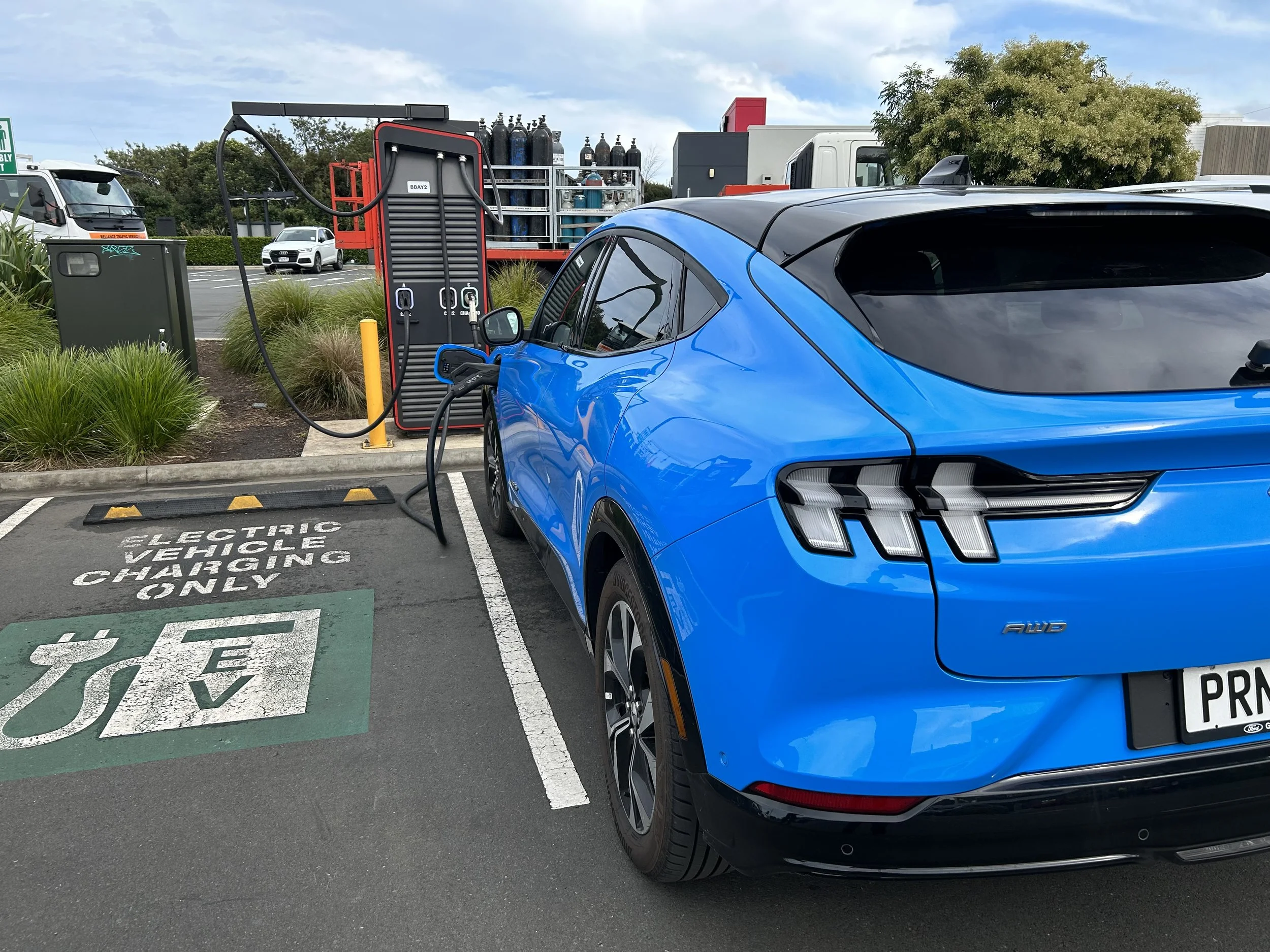Ford Mustang Mach-E first drive: Pony play just got zappy
/An America classic rebirths as an electric sports utility family ride. Tough if you’re still troubled.
DRIVEN at last, bearing a name some still say is undeserving, a car so vital its maker will withstand never making a single cent of profit from it: Mustang Mach-E.
That wasn’t anticipated. In its first full year, 2020, Mach-E was profitable, but after that commodity costs – including for the lithium ion phosphate battery, from China’s CATL – mitigated margins.
Electric cars are high stakes. Particularly for Ford Motor Company. Detroit’s electric vehicle investment requires an $NZ89 billion-plus spend by 2026. It has the money and its most important car of this generation not making any contribution - regardless it was the third best-selling EV last year and has achieved quarter of a million sales - won’t erode commitment, though Ford has learned. It’s exploring the idea of vertically integrating raw materials into its business and switching from lithium-ion batteries to cheaper lithium iron-phosphate types.
Meantime, Mach-E sticks true to Ford’s ideals. Some cost-cutting, but only in production, not to the car itself, which has suffered no-decontenting. On the contrary, it has been improved with software updates and a big suspension retune. That a certain barometer car from a certain other North American maker driven by different ideology and a different style of leadership would play so cool.
Mach-E isn’t cheap, but it prices squarely to the market, not least in Clean Car rebate-earning base format, where the cost is a joy, given the base car’s capacity, capabilities and content. It’s a big taste of America for the same price that otherwise buys physically smaller alternates.
What to make of it? The first taste has become a week-long immersion as I drove home in that rear-drive $79,990 entry car, eligible for $8675 Clean Car discount until July 1 and $7015 thereafter, for test. I’ll come back, in time, on how that assessment goes.
Today’s story is more specific to the media event and chance to get a taste of all three NZ-market variants: The entry - with a 75kWh (70kWh usable) battery and single motor - and the mid-spec All Wheel Drive and the top line GT. These each have a 98.7kWh (91kWh usable) type and dual motors, but each in markedly different performance tune, and cost $109,990 and $124,990 respectively.
Focus for me was sifting through the pack to pick out the NZ-spec cars. To explain. Ford NZ has had a small fleet of Mach-E AWDs here for a little while, but all Ireland market product, running the small battery.
NZ-market cars are only now rolling out. The GTs, which we solely drove at Hampton Downs circuit, were Kiwi cars, but just one all-wheel-drive and one rear-drive had that status. I managed to nab those.
Before going further, the big issue. Like it or not, it IS a Mustang. One that doesn’t look, or drive, like the kind of Mustang you may have already met. Yet give it a chance. From my experience, in respect to performance and styling, it has a lot that you might have hoped to get from an electric SUV with that name.
Agreed, there’s no way Ford could make a five door SUV look like a low-slung two-plus-two (barely) that’s never had more than two doors. So they haven’t. The point of the exercise has instead been to incorporate as many familiar design cues as they imagined they could get away with. The primary muse to draw from was the original, 1965 Mustang GT, the one on which the pony car legend was built; but the larger, more muscular late 60s’ car has also influenced. The famous grille has gone west, of course, but it has something of the same roofline shape, a hint of the coke bottle waist, the familiar fat haunches and, most patently, pretty much the same triple element tail lights.
The people who own the Mustang name and feel they have a goddamn right to use it how they please (as they do, so resistance is futile) are nonetheless likely poking the bear by plastering big pony logos all over the show; big ones on the nose and tail, teensy ones on the wheel centres. It’s embossed on the steering wheel and shows on the screens when you hit the starter. All this horsing around, but no Ford badges, save on the windscreen. Weird?
The performance setting, called Untamed/Untame here and Unbridled in America (either way a nod to the theme), might also goad old-schoolers’ growling. In addition to making acceleration more instant, this mode also pipes in fake V8 engine noise. You know, for “character”.
However you feel, it’s not an unattractive car. The look as a whole might run wide of the stereotype of a ‘Stang, but it does suggest there’s performance on offer and, in the ‘right’ colour (I’d elect the Grabber Blue seen today) you cannot deny the definite ‘wow’ factor.
The interior will be foreign territory not only for Mustang coupe faithful but anyone familiar with any kind of current Ford. Layout-wise, it divorces from anything familiar - save the indicator and wiper wands - that the Focus/Escape/Ranger and, in fact, the Mustang coupe provision for something all new, in which almost all the functions usually worked by a combination of buttons and controllers become touch screen prompts. The layout is a bit like that in a Volvo XC40, though the materials aren’t as swish. Ford likely also took cues from the Tesla Model 3 and Y, though they’ve avoided Elon’s ergonomic errors. Either way, it does a lot to make the car come across as being properly futuristic and tech-centric.
The 15.5-inch portrait infotainment touchscreen runs the fourth-generation of Ford’s in-house Sync infotainment which works well, with the fastest wireless Apple CarPlay/Android Auto linking I’ve experienced. The screen itself is bright, clear and easy to use with crisp graphics. The only actual button is a massive silver donut-shaped dial for the volume, atop the glass.
There’s also a 10.2-inch digital instrument cluster behind the steering wheel, displaying the bare basics: speed, battery charge, the info from the driving assistance systems. As in petrol Mustangs, the speedo labels as a ‘ground speed’ device; prioritising kmh, but given mph in a smaller type as well. Just to remind of its birthright, I guess.
What also makes Mach-E a new experience for Mustang folk is that it’s scaled for a duty no coupe can ever seriously undertake; genuinely proper family usage. Call it ‘fat Elvis’, but also admire the abundance of space.
Electric cars are generally decent in this regard because, like this one, they have flat floors, but the Mach-E is sized for America. As is the Tesla Model Y, which also impressed me. Without getting out a tape measure, I’d say the Ford is larger inside. It’s a whopper with extra whop.
Before driving, I set up the front seat to suit my frame then sought sit behind it. There was heaps of leg and foot room. Head room isn’t an issue, either, even in the GT, which gets a panoramic sunroof. In respect to comfort, the base car has a poorer front seat than the all-wheel-drives, but otherwise it’s hard to fault.
As well as being roomy, it has lots of practical touches. Along with a generous 519-litre boot, accessed by a large tailgate that is a bit awkward in the base car as it lacks the the hands-free electronic operability in the more expensive models and asks you feel under the lid’s bottom for a small release button that’s a magnet for grime, a 'frunk' under the bonnet is lined with tough plastic and has a drain plug so it can be washed out.
The doors have an anti-finger squish feature, which is clever, but the jury’s out of the door openers being a small button rather than a traditional handle. A numerical key code panel on the driver’s doors is a common US market thing rarely exported; it allows an extra layer of security for keyless locking and unlocking but isn’t mandatory use. I remember Nissan tried those on a Maxima for a while, but buyers weren’t into it.
The all-wheel-drive cars are better provisioned than the vase, but th entry car has some decent stuff; even though the front seats are wholly manual adjust, they’re heated, as in the steering wheel rim.
Mach-E also provisions a huge amount of safety kit, from the usual blind-spot warning system, to front and rear parking cameras. The standard ‘Pre-Collision Assist’ pack gives collision mitigation, forward collision warning, dynamic brake support and evasive steer assist. Adaptive cruise control and lane keeping assistance are also standard. All types have cameras giving rear and front views, but the GT alone achieves 360-degree cameras to help with parking what is a pretty big car.
Time to get a move on. The Mach-E can be driven using one of three driving modes, each with its own distinct personality. Active is default, Whisper is basically what other makers would call ‘eco’ and prioritises range and gives the throttle pedal a smoother delivery. Untamed is full power.
On GT, within a sub-menu, there’s actually an ‘Untamed Plus’ that on the driving course comprising, in consecutive order, a slalom, a swerve test designed to mimic a sharp lane change avoidance and a full out drag race added tangible extra salsa, though the throttle response, already hair trigger in Untamed, became even more brutal. But only for around two goes, each lasting five minutes at most. Then it quit.
I’d say it’d be a heat issue. Few electric cars tend cope with repeated hard-hoofing. Those back-to-back attacks caused the Easter Egg feature to crack.
That’s not to say this thing is soppy. Far from it. Electrics are almost always enlivening. Performance-wise, even the base Mach-E makes extremely honest use of the 198kW/430Nm on offer. It alone will be fast enough for the vast majority of SUV buyers.
The Volkswagen ID.4, Kia’s EV6 and Hyundai’s Ioniq 5 and Tesla’s Model 3 at the same price will all likely prove to have have similar zest though some cannot match the Ford’s 0-100kmh time of 6.1 seconds.
As athletic as it is, the cheapest is nonetheless the weakling of the family. Don’t bother using it to challenge the bigger battery types; they have heaps more oomph.
At same token, the track exercise reinforced that significant disparity also exists between the AWD and the GT. With 258kW/560Nm and a 0-100kmh of 5.1, the mid-spec car is, in isolation, a spirited performer; I had a lot of fun with it on back roads south of Auckland.
Out on the track, though, it was totally destroyed by that 358kW and 860Nm GT. The flagship is a monster and you can understand why: To put a credible electrified twist on the muscle car heritage, it needed to be a brute.
It really is. It’s much quicker off the line than any V8, with 0-100kmh in 3.7 seconds but this, and the status as the faster five-seater Ford ever, doesn’t really relate just how walloping it is. It’s the massive wall of thrust beyond the initial kick-off that also gets you. This is a car that was momentarily wheel spinning all four tyres off the line.
What also impresses is the sense of confidence it shares. I’m sure it will bite, ultimately, but there’s a lot of big kid playfulness here. It could be goaded with little effort into a consistent series of sweet wholly throttle-modulated drifts between the cones on the slalom. For sure, you could really feel its weight shifting on to the outside wheels when it turned in to a corner with any zeal, but it was still easy to manage.
If I were Kia NZ, I’d be rethinking the prudence of siting the 430kW/740Nm EV6 GT at $140,000. I’ve got a feeling this version of Mach-E is going burn the Korean racer and more besides. If it’s as hot and as handy on the road as it is on the track … well, just watch out.
The flagship’s effort comes at expense of range, which drops to a cited 490kms, whereas the AWD will cover 550kms. Those are still better than the entry car, however which is claimed to get 440km on a charge.
These, of course, are all ‘at best’ returns. The rear drive’s big run simply further confirmed my feel that, just like internal combustion engine cars very seldom get the combined WLTP fuel figure, no EV gets what is claimed.
That 482km run home required two replenishments back to 80 percent, the first when the car was at 56 percent and had 207kms range left (bumped back to 316km), the second two hours and 182kms on, when the battery was down to 26 percent and had 87kms’ impetus left, according to the trip computer. I still had 187kms yet to tackle.
Almost all the driving, by the way, was in Whisper, which is the most efficient and also softens the throttle response, making it easier to drive smoothly, and without assistance from the one-pedal braking, which does what it says on the tin, and will slow the car to a stop in most situations when you lift off the accelerator.
There’s another aspect about Mach-E you might have read about. The dynamic quality, specifically in respect to ride. In its first two years’ production the car was bagged for being only average for handling and bump suppression.
A big retuning resulted and consensus is that it has made it better, if not perfect. Cars built since late 2022 get the new set-up, so logically the NZ-specific product has it, as those cars have only recently begun build. Ford NZ said it knew nothing of this and could not say if the Ireland cars, from the 2022 build cycle, were ‘pre’ refresh or ‘post’.
We never got to drive the GT on the road, so I cannot offer any thought about that. Just the AWD and the rear-drive were experienced away from the circuit.
But then, the flagship could well be different, anyway, as it gets adaptive suspension and a lower ride height than other versions. on track, it feels far more tied down and settled, giving you confidence to push on. I’d assume that’d be the same on the road.
Regardless of how they tailor, all Mach-Es weigh over two tonne, which is a fair bit to throw around. A Mustang coupe itself has substance, but the SUV has a heavier feel.
The base car unsurprisingly has a nicer steering feel - because it’s unencumbered by any motor influence on it.
The AWD has heavy steering, and I’m a bit dubious about the drive system’s torque response set-up. It is designed to direct plenty of power rearwards to help prevent the nose from running wide. That wasn’t so evident in the one I took for a blat. You could sense the push-pull fight between the power steering trying to do its job and the front drive motor seeking to lay down its grunt. also, that car demonstrated some secondary bob and pitch secondary movement on exiting a corner. It felt a bit raw, frankly. Then again, it didn’t seem so bad on the track. Neither did the GT.
Insofar as ride quality, the base car on its 18-inch rims and 225/60 Continentals won the day; it has genuine compliance that suits this level of presentation. I love that the GT is on 20-inch 245/45 Pirelli P-Zeros but would hope it has a better resolved ride quality than the AWD, which was choppy, with coarse chip generating quite a lot of texture feel. It runs Bridgestone Turanza 225/55 R19s.
Ford’s formidable performance car heritage obviously hangs over a car Ford simply had to make, for a future it cannot avoid, yet ’is it a Mustang’ is an irrelevance. As said, Ford owns the name and has used it as it saw fit, quit your whinging. As an FYI, Ford NZ says the national owners’ club voted acceptance. The more reasonable question is: ‘Is it as sporty as a Mustang should be’? On evidence presented so far, the GT fully makes that muster, the AWD largely does and the base less so, though on experience so far the last might be the nicest daily drive.
Mach-E is a bold start, but not a wholly fresh one. Old habits die hard for Ford. At this very moment there is no petrol pony presence in the showroom, as the current coupe has hoofed the scene, but this time next year, the electric will have another, V8-only evolution of the old-school Stang selling alongside it.
The author attended this event as a guest of the distributor, with travel, accommodation, meals and a modest gift provided.


